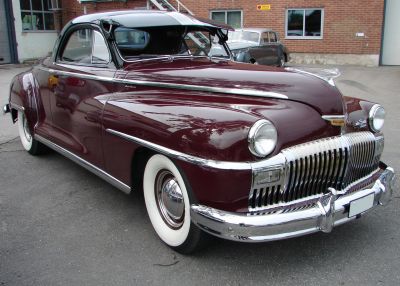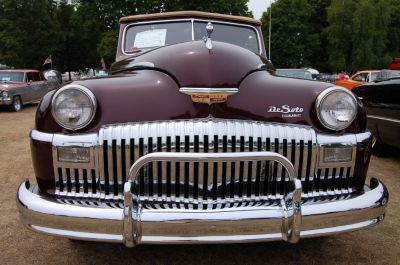 1946 DeSoto Custom Club Coupe Dimensions, Size & Specs
1946 DeSoto Custom Club Coupe Dimensions, Size & SpecsMeasurements of the 1946 DeSoto Custom Club Coupe, engineered for optimal performance and comfort
| Dimensions | |
|---|---|
| Length: | 5265 mm207.3 in17.3 ft |
| Width: | 1923 mm75.7 in6.3 ft |
| Height: | 1687 mm66.4 in5.5 ft |
The DeSoto Custom Club Coupe, produced between 1946 and 1949, represents a classic example of American post-war automobile engineering and design. This full-size coupe was a notable model in DeSoto's lineup, emphasizing elegance and spaciousness. Measuring an impressive 5265 mm (207.3 inches) in length, the Custom Club Coupe offered substantial road presence and roomy interiors suitable for comfortable cruising. Its width of 1923 mm (75.7 inches) provided ample shoulder room for passengers, enhancing in-car comfort. The vehicle's height of 1687 mm (66.4 inches) contributed to a balanced and dignified stance without compromising aerodynamic aesthetics of the era. These dimensions exemplify the larger proportions common among American cars of the late 1940s, reflecting both luxury and utility in design. Whether compared to contemporary vehicles or other classic coupes, the DeSoto Custom Club Coupe's size solidifies its status as a spacious coupe meant to deliver both style and substance. Enthusiasts and historians appreciate the car not only for its vintage charm but also for its sizeable footprint that echoes the grandeur of the period's automotive trends.
Discover the standout features that make the 1946 DeSoto Custom Club Coupe a leader in its class
Have a question? Please check our knowledgebase first.
The 1946-1949 DeSoto Custom Club Coupe is a large classic coupe with notable proportions for its era. It measures 5265 mm (207.3 inches) in length, providing a spacious footprint that contributes to its presence on the road. The width is 1923 mm (75.7 inches), giving the vehicle a broad stance and stable handling characteristics. Its height stands at 1687 mm (66.4 inches), which is relatively tall compared to modern coupes but typical for cars from the mid-20th century. These dimensions emphasize the car's design focus on comfort, road presence, and passenger space.
With a width of 1923 mm (75.7 inches), the DeSoto Custom Club Coupe offers a roomy cabin that comfortably accommodates two to three passengers in the front and usually a similar arrangement in the back seats. The generous width allows for wider seats and enhances shoulder room, contributing to overall passenger comfort. At 1687 mm (66.4 inches) tall, the car provides ample headroom, which is somewhat higher than many modern coupes. The combination of width and height strikes a balance between an open, spacious feel inside and a commanding driving position that helps drivers better perceive the road.
The DeSoto Custom Club Coupe's length of 5265 mm (207.3 inches or approximately 17.3 feet) is considerably longer than many modern cars, especially compact ones. A standard modern garage is typically about 6 meters (20 feet) deep, which means the Coupe will technically fit inside a standard garage but with limited extra space to spare. This means owners should measure their garage carefully, especially if additional room is needed for opening doors or storing items. While it will fit, the close quarters can make maneuvering and parking a bit more challenging compared to smaller cars.
Compared to its pre-World War II predecessors, the 1946-1949 DeSoto Custom Club Coupe generally features increased dimensions, especially in length and width. Postwar designs focused on a larger and more luxurious appearance to appeal to consumers looking for comfort and status. The 5265 mm (207.3 inches) length and 1923 mm (75.7 inches) width give it a more substantial road presence than the earlier 1930s and early 1940s DeSoto coupes, which were typically shorter and narrower due to the different automotive design trends of those times. This evolutionary size increase reflected advancements in suspension, chassis design, and consumer demand for larger cars after the war.
The DeSoto Custom Club Coupe was competitive in size compared to similar luxury and mid-range coupes from American manufacturers such as Buick, Oldsmobile, and Chrysler during the late 1940s. Its length of 5265 mm (207.3 inches) and width of 1923 mm (75.7 inches) fall within the upper mid-size to large coupe category. For instance, comparable Buicks or Oldsmobile coupes from the same era often exhibited lengths around 5 meters (approximately 197 inches) and similar widths, making the DeSoto quite spacious. This indicates that DeSoto aimed to offer a comparable level of comfort and presence to compete well in its segment.
The DeSoto Custom Club Coupe is a two-door coupe, which was a popular body style in the 1940s for personal luxury and sporty appeal. The coupe design emphasizes style with a sleek roofline and generally two doors instead of four, often prioritizing driver and front passenger comfort along with a stylish profile. While the coupe shape reduces rear seat ease of access compared to sedans, it appeals to buyers seeking a sportier, more exclusive look. This vehicle type often features a more robust and stylish exterior design, making it ideal for enthusiasts valuing design and performance characteristics over maximum passenger capacity.
With a height of 1687 mm (66.4 inches) and a width of 1923 mm (75.7 inches), the DeSoto Custom Club Coupe stands taller and generally wider than many modern coupes and even some sedans. Today, many coupes have lower heights (often below 1400 mm or 55 inches) to create sportier, more aerodynamic profiles. The greater height of this classic coupe contributes to a commanding driving position and a more spacious interior. The wide stance enhances stability and road presence but can also make the car feel bulkier compared to more streamlined modern vehicles. Overall, these dimensions create an impression of a grand and substantial automobile with a strong road presence.
Given its large exterior dimensions—length of 5265 mm (207.3 inches), width of 1923 mm (75.7 inches), and height of 1687 mm (66.4 inches)—the DeSoto Custom Club Coupe offers a generous interior space that is quite comfortable for long trips. The wide cabin allows for comfortable seating arrangements with ample shoulder room, while the height gives sufficient headroom to avoid cramped conditions. The large footprint traditionally translates to sizable legroom in both front and rear seats, supporting extended comfort for passengers. Additionally, the coupe design includes sufficient trunk space for luggage, making it suitable for long-distance touring or weekend getaways.
While specific weight data is not provided here, vehicles of the size and era of the DeSoto Custom Club Coupe typically weighed between 1700 kg to 2000 kg (3750 lbs to 4400 lbs). This substantial weight, combined with the car's large dimensions, means that performance is focused more on smoothness and comfort than outright speed. The heft enhances ride stability and road presence but can reduce fuel efficiency due to increased engine load. Engines in cars from this period were optimized for torque and durability rather than economy, so fuel consumption is generally higher than modern vehicles. The weight also impacts handling characteristics, requiring careful driving, especially on narrow or winding roads.
The DeSoto Custom Club Coupe produced from 1946 to 1949 occupies an important place in post-World War II American automotive history. Emerging after the war, the model represented the industry's return to civilian vehicle production, blending prewar luxury with newer styling and engineering advances. During these years, DeSoto positioned the Custom Club Coupe as a stylish, upscale vehicle appealing to consumers seeking refinement and performance in a coupe form. Its robust size, stylish design, and reliable performance helped cement DeSoto's reputation in the competitive mid-tier luxury market of the late 1940s. This generation also reflects broader trends of the time, including shifting consumer preferences toward larger, more comfortable vehicles after wartime austerity.
Discover similar sized cars.

| Production: | 1946-1949 |
|---|---|
| Model Year: | 1946 |
| Length: | 5265 mm207.3 in |
| Width: | 1923 mm75.7 in |
| Height: | 1687 mm66.4 in |

| Production: | 1946-1949 |
|---|---|
| Model Year: | 1946 |
| Length: | 5265 mm207.3 in |
| Width: | 1923 mm75.7 in |
| Height: | 1687 mm66.4 in |
